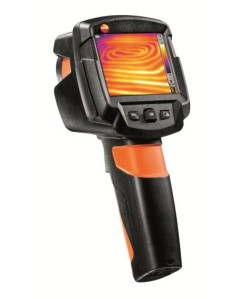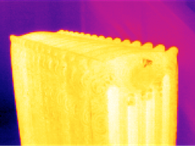 The latest addition to the Testo family of infrared thermal cameras is the Testo 870 Thermal Imager. It is a quick, compact unit that combines excellent picture quality with a wide angle lens and a great price point. The 870 is offered in two models, the Testo 870-1 Thermal Imager and the Testo 870-2 Thermal Imager. At times this family and model nomenclature can be cumbersome, but in this instance Testo keeps it simple. There is only one difference between the 870 siblings: the 870-2 includes a visible light camera while the 870-1 does not. Otherwise the two are exactly the same, from the housing to the internal components.
The latest addition to the Testo family of infrared thermal cameras is the Testo 870 Thermal Imager. It is a quick, compact unit that combines excellent picture quality with a wide angle lens and a great price point. The 870 is offered in two models, the Testo 870-1 Thermal Imager and the Testo 870-2 Thermal Imager. At times this family and model nomenclature can be cumbersome, but in this instance Testo keeps it simple. There is only one difference between the 870 siblings: the 870-2 includes a visible light camera while the 870-1 does not. Otherwise the two are exactly the same, from the housing to the internal components.
Hardware
As you pick up the Testo 870 you will immediately note that the build quality is excellent, with the fit and finish being what one would expect from a quality German company. Here in America it is easy to forget that Testo is a household name in Europe, synonymous with the best in test instruments. The quality and design of the 870 offer a bold reminder that Testo brings a wealth of experience to the table.
The Testo 870-1 and 870-2 Thermal Imagers are built around a 160 x 120 thermal detector core, offering a total of 19,200 pixels. The detector is sensitive to 0.1 ºC temperature differences, enough to spot anything from footprints on the floor to airflow moving around inside a stud cavity. For those users in the building industries, including home inspection and energy auditing, this resolution and sensitivity meet the RESNET Guidelines for Thermographic Inspections of Buildings. The Testo 870 can measure and image temperatures up to 536 ºF, the highest in this class of infrared cameras.
For better viewing in tight quarters, Testo has affixed a wider 34º lens. This is welcome trend in infrared cameras, giving the user a wider field of view in the image. While the wider lens increases spot size for temperature measurement, it is nonetheless a huge advantage when performing qualitative thermography, comparing one target (or part of a target) to another. For instance, with a wider lens you can now get more of a wall in one picture, and you don’t need to back up as far to capture large areas. The lens of the Testo 870 is fixed in place with no need to focus, and will give a quality picture of everything at least 19 inches away.

Easy to spot this heating pipe in the wall (bright yellow), and the missing insulation around the right window (dark orange).
As mentioned above, the sole difference between the Testo 870-1 and the Testo 870-2 lies in the presence or absence of a visible light digital camera. The 870-2 includes a 3.1 MP digital camera that captures the target area as it appears in everyday conditions. This is a great feature for reporting purposes, helping users as well as customers understand where the problem area is located and what may be causing a thermal anomaly. The Testo 870-2 automatically stores a visible image alongside the thermal image each time the trigger is pulled. The two are paired together in the image gallery for easier recall later.
The housing itself is composed of a combination of hard and soft rubberized plastics. The balance and ergonomics of the Testo 870 are excellent. It’s not a large or heavy camera to begin with, and the more we use it, the more we find it to be a natural extension of our work. The screen is a large and bright 3.5” LCD, giving a great view of the targeted area.
Software
Perhaps the greatest feature of the Testo 870 is its ability to use Testo’s patented SuperResolution technology. SuperResolution is a $395 option that effectively quadruples the resolution of the camera from 19,200 pixels to 76,800 pixels. This is not a simple interpolation or averaging of pixels to create a larger image, but rather more true resolution of the same target. SuperResolution takes a series of images very quickly, each image being slightly offset due to the natural movement of the human body. When loaded into the PC software, the data from these images are used to create one new image offering four times the initial resolution. Four times the true thermal data points–effectively a 320 x 240 thermal imager. Time for some math: an 870-1 with the SuperResolution option would cost $2590. The next closest thermal cameras that can offer 320 x 240 performance cost around $6000. If you’re after resolution, there’s simply no way to get more of it for your money than with the Testo 870.

Testo’s SuperResolution option quadruples the resolution of the 870. Standard image at left is 160 x 120. SuperResolution image on the right is 320 x 240 pixels. Click for larger view.
The user interface of the Testo 870 borders on a work of art, getting high marks for its simplicity and intuitiveness. We found we could get to where we needed to be quickly and with minimal stress. The 870 offers the classic center spot temperature measurement, as well as automatic hot and cold spot detection. Four color palettes are available including the standard iron and rainbow. Analysis and reporting are handled through the included IRSoft PC compatible software. Other available accessories include extra batteries and an external battery charger.
Final Thoughts
The Testo 870 Thermal Imager offers a very compelling package for anyone looking for a 160 x 120 thermal camera. The excellent European design combined with solid German build quality inspire confidence. The wide angle lens and focus-free operation of the 870 make quick work of infrared scans, and its wonderful simplicity leave room to talk to a client while performing an inspection. Finally, the SuperResolution option gives the a full 320 x 240 resolution at less than half the price of any other solution. The Testo 870 is an impressive camera in many regards–but it’s that last one that really keeps us talking.

Pingback: Thermal image photos - InterNACHI Inspection Forum
Pingback: Infraspection course worthwhile? - Page 2 - InterNACHI Inspection Forum
Pingback: Narrowing it down what do you think - InterNACHI Inspection Forum